Menus
- Compressor monster
- Up to 6000, 8000 revolutions everything feels reasonably normal
- The real madness is the Kawasaki H2R
- First lap with due respect
- Engine of the Kawasaki H2R a beast
- Workmanship down to the last detail and beautiful to look at
- Technical data Kawasaki H2
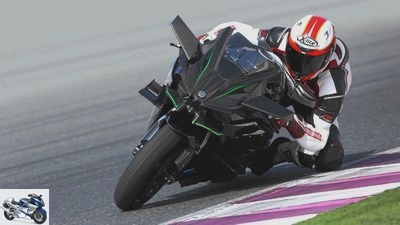
Kawasaki
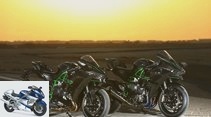
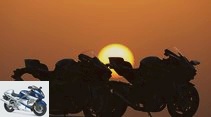

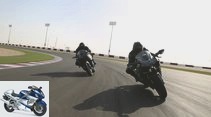
33 photos
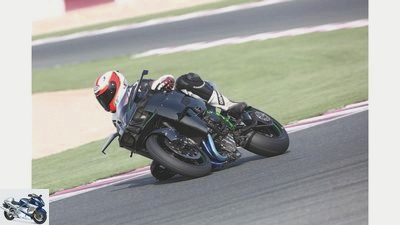
Kawasaki
1/33
Kawasaki H2 / H2R.
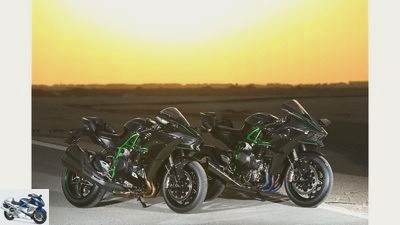
Kawasaki
2/33
Kawasaki H2 / H2R.
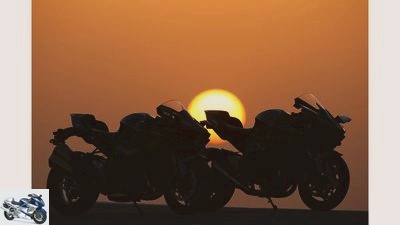
Kawasaki
3/33
Kawasaki H2 / H2R.
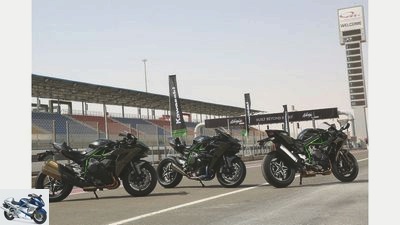
Kawasaki
4/33
Kawasaki H2 / H2R.
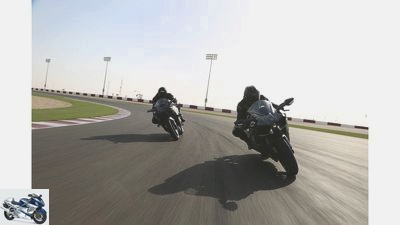
Kawasaki
5/33
Kawasaki H2 / H2R.
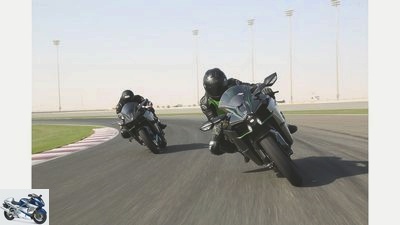
Kawasaki
6/33
Kawasaki H2 / H2R.
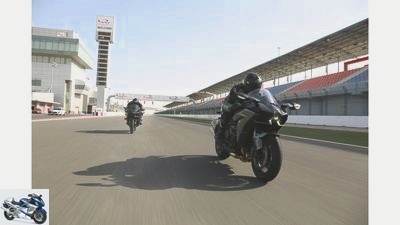
Kawasaki
7/33
Kawasaki H2 / H2R.
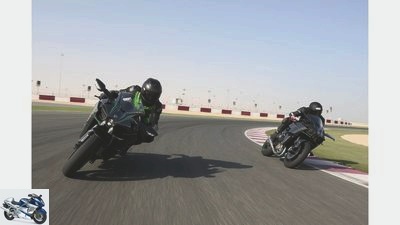
Kawasaki
8/33
Kawasaki H2 / H2R.
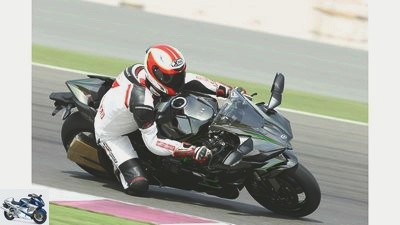
Kawasaki
9/33
Kawasaki H2 / H2R.
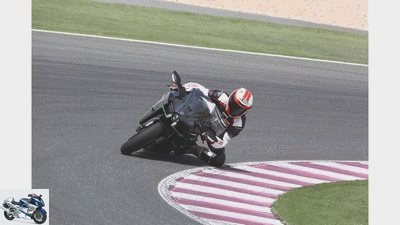
Kawasaki
10/33
Kawasaki H2 / H2R.
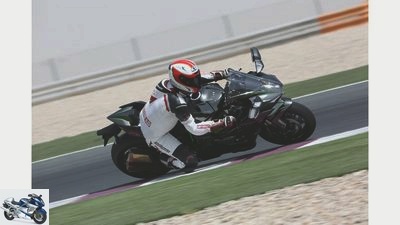
Kawasaki
11/33
Kawasaki H2 / H2R.
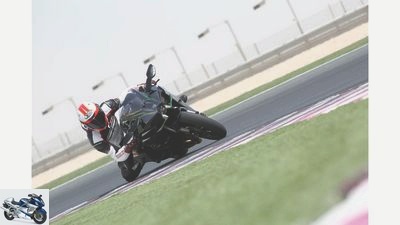
Kawasaki
12/33
Kawasaki H2 / H2R.
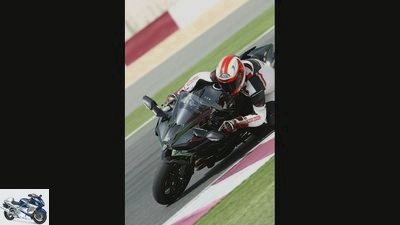
Kawasaki
13/33
Kawasaki H2 / H2R.
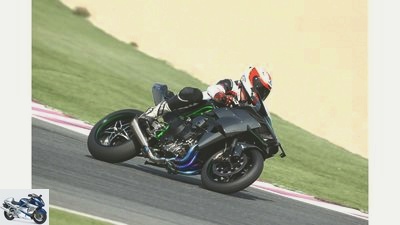
Kawasaki
14/33
Kawasaki H2 / H2R.
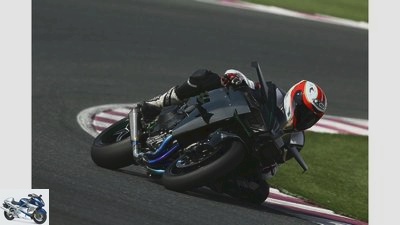
Kawasaki
15/33
Kawasaki H2 / H2R.
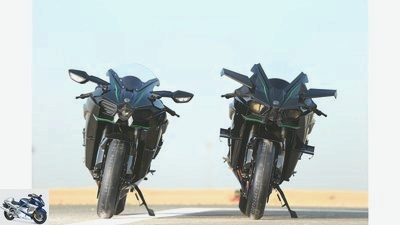
Kawasaki
16/33
Kawasaki H2 / H2R.
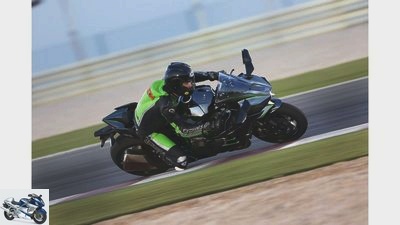
Kawasaki
17/33
After a 15-minute turn with the H2R, the mechanics have to work –
Change the rear tire.
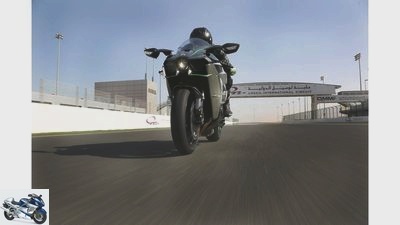
Kawasaki
18/33
Kawasaki H2 / H2R.
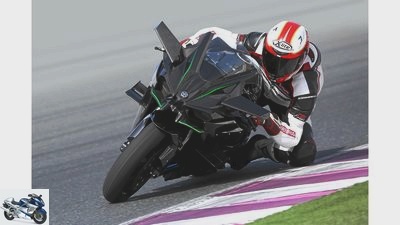
Kawasaki
19/33
What a ride on Kawasaki’s supercharged monsters H2 and H2R means, their performance data cannot even begin to express.
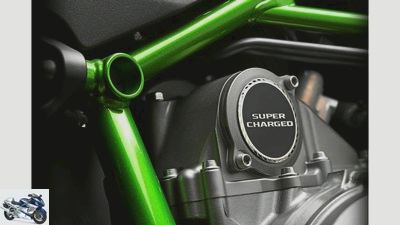
Kawasaki
20/33
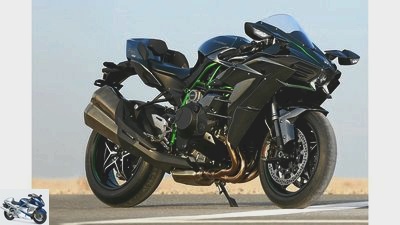
Kawasaki
21/33
Kawasaki H2: 200 hp – 133 Nm – 299 km / h – 25,000 euros.
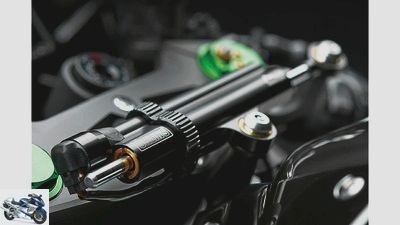
Kawasaki
22/33
The electronically controlled Ohlins steering damper hardens the damping with increasing speed and is tuned differently for H2 and H2R …
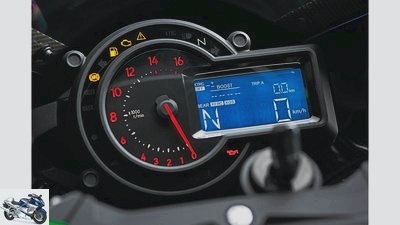
Kawasaki
23/33
… The cockpit looks almost businesslike and has a boost pressure display …
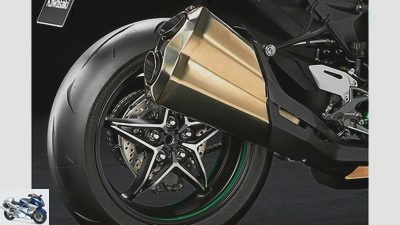
Kawasaki
24/33
… An exhaust like a club. It not only looks difficult, but there is an alternative from Akrapovic.
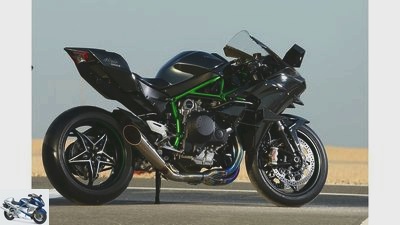
Kawasaki
25/33
Kawasaki H2R: 310 hp – 165 Nm – over 350 km / h – 50,000 euros.
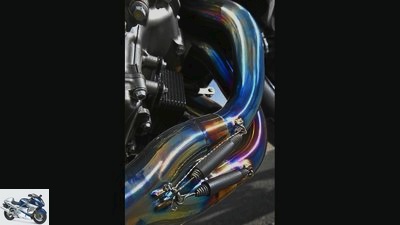
Kawasaki
26/33
The complete exhaust system of the R is made of titanium, the first oval, then round manifolds measure 48 mm (H2: 45 mm) and are shaped by hydroforming …
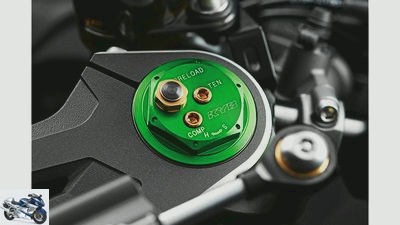
Kawasaki
27/33
… Slightly more tightly tuned Kayaba suspension elements and 22 kg less weight result in significantly more agile and crisp driving behavior …
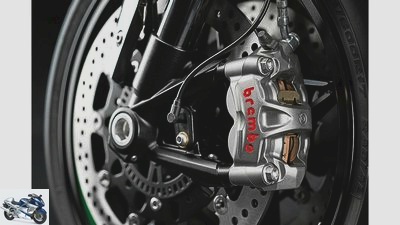
Kawasaki
28/33
… Only Brembo components that meet particularly high quality requirements are used.
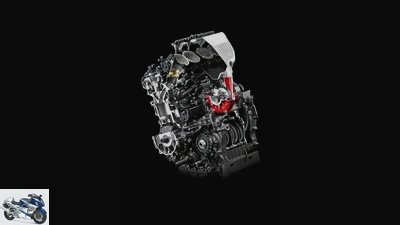
Kawasaki
29/33
The rigid and sealed aluminum airbox must also withstand the maximum 2.4 bar boost pressure of the compressor. It sits well integrated behind the cylinder block.
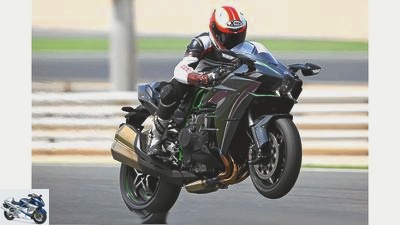
Kawasaki
30/33
Only 50 H2 and five H2R come to Germany – all of them already sold. But supplies are planned for 2016.
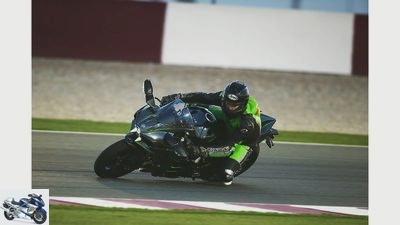
Kawasaki
31/33
Kawasaki H2 / H2R.
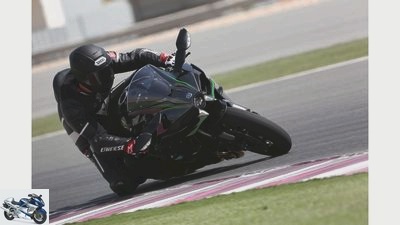
Kawasaki
32/33
Kawasaki H2 / H2R.
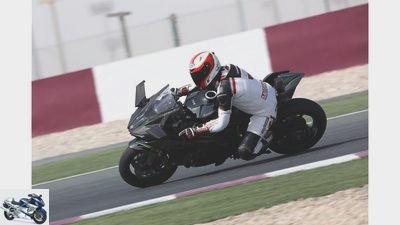
Kawasaki
33/33
Kawasaki H2 / H2R.
Kawasaki H2 and H2R in the driving report
Compressor monster
Numbers only reflect half the truth. What a ride on Kawasaki’s supercharged monsters Kawasaki H2 and Kawasaki H2R means, their performance data cannot even begin to express.
No, honestly, they are not to be envied. Greasy and shiny come under the electric blankets that the mechanics of the KUnwind awasaki H2, brand new Bridgestone V01 slicks emerge. They won’t live long. Because with the Kawasaki H2, the first compressor-charged production motorcycle is waiting for them. Mechanics bring four of these power monsters up to temperature in the pit area in Qatar with powerful bursts of gas. The growling rumbling and hissing as the engine speed increases is mixed with threatening hissing and buzzing, an Aeolian whistling like that of oversized dental drills. Expressions of life of the loader.
Buy complete article
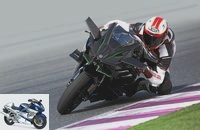
Kawasaki H2 and H2R in the driving report
Compressor monster
“The ride of your lifetime”
Resourceful inventors planted turbochargers and compressors on production motorcycles even earlier. And current series 1000s already offer 200 hp. But not in combination with 133 Newton meters of torque and a full power curve. The charger was included in the engine design from the start. Cooling and lubrication are integrated into the existing circuits. The five liters of engine oil are used for lubrication. Cool air is sucked in via a powerful intake duct on the left around the engine, so no intercooler is required. The mechanics push the machines out of the boxes. “The ride of your lifetime” should offer the Kawasaki H2, said press spokesman Martin Lambert the evening before. Well then.
But first of all, the Kawasaki H2 surprises with a comfortable workplace. The handlebars sit 10 mm higher and the notches 10 mm further forward than on the Kawasaki ZX-10R. In addition, narrow tank flanks, sufficient freedom of movement on the seat cushion, the rear part of which can be moved by 15 mm for optimal support when accelerating. The clutch does not require a catcher handle, nothing feels like monsters. The first corners still rule the caution, you never know. The switching processes are surprisingly crisp and with very short distances on the stage. The so-called Dog Ring transmission, which comes from racing, is responsible. The shift forks do not shift the gear wheels. They stay in place on the gear shaft. Slidable drive plates create the frictional connection between the transmission shaft and gear wheel.
All tests and articles about the Kawasaki Ninja H2
All tests and articles about the Kawasaki H2R
Up to 6000, 8000 revolutions everything feels reasonably normal
Up to 6000, 8000 revolutions everything still feels reasonably normal, like with a fairly powerful series 1000. But then the fun begins. The Kawa takes a deep breath and sprints away as if with seven mile boots. The thrust is enormous, inexhaustible, no matter how high the speed increases. Accompanied by the buzzing and chirping of the loader, the Kawasaki H2 pulls the road through with a monkey tooth. The punch is heavy. In a long left-hand curve, the second to the fourth are fully charged. The force of the engine kneads the tires and shock absorber powerfully, the rear pumps under the strain. Setup changes can at least bring calm to a large extent.
The irresistible way in which the supercharged 1000 meter rushes towards its peak is unique: powerful, but even. So evenly that you get caught in the limiter at almost 14,000 rpm and then quickly shift to the next gear using the automatic gearshift (only designed for upshifting). What follows is thrust, thrust, thrust. After a few laps, at the end of the one-kilometer home straight, the speedometer shows 299 km / h. The brake cocktail of 5.5 mm thick 330 mm discs, Brembo four-piston calipers and radial pump captures the Kawasaki H2 lap after lap without fading. The Brembo components have to adhere to particularly tight tolerances in order to make it into the H2. The coordination of the stoppers was not overly snappy, the pressure point was rather soft.
The real madness is the Kawasaki H2R
Although the tank weighs 238 kilos (factory specification), the Kawasaki H2 dives surprisingly willingly into the corners, perhaps not quite as necessarily on the tight line as a thoroughbred super sports car. But for those who are after the last tenth when filing times, there is the ZX-10R. Chasing times is not the determination of the H2, brute acceleration is. Stability, accuracy and handling are still on a decent level. The throttle response, however, was pretty hard, almost aggressive. A little too motivated to accelerate in second-gear turns, and the H2 snaps forward tremendously and the pulse skyrockets. A little thrill is also part of the “ride of your lifetime”.
But the real madness is still waiting in the boxes. It goes by the name of the Kawasaki H2R. 310 hp, 165 Newton meters. Even hardened testers get wet hands. Before the technicians bring the machines to life, they hand out ear plugs and earmuffs. Then all hell breaks loose. With barbaric, barely muffled roars from their all-titanium exhaust systems, the H2R come to life. The bowels tremble with every throttle, in a MotoGP box it is not louder. And a lump in the throat joins the damp hands.
First lap with due respect
The first round is approached with due respect. But even then, the Kawasaki H2R indicates that it is swinging a much more powerful hammer than its street-ready sister. If the Kawasaki H2 only draws in fresh air through an opening in the nose of the fairing, both nostrils of the H2R are free. Sharper camshafts, different head gaskets and – in addition to the open exhaust system – an ECU with adapted mapping unleash the four-cylinder. Then the home straight is reached for the first time – and the hammer falls. The supercharger, driven by a planetary gear, rotates at 9.2 times the crankshaft speed and operates with a maximum of 2.4 bar boost pressure. It sucks in 200 liters of air per second at a speed of 100 m / s into its compressor housing. Five to ten times that of a naturally aspirated engine.
Acceleration is when the tears of emotion flow horizontally backwards, as rally legend Walter Rohrl once said. He would have loved the Kawasaki H2R. As if fired from a catapult, the H2R shoots its pilot down the straight. Even a MotoGP machine would have to dress warmly for a sprint duel. At maximum speed, the supercharger’s CNC-milled compressor wheel rotates at 130,000 rpm – far more than the speed of sound. And that’s exactly how the driver feels! The pulse is pounding, no time to pay attention to anything left or right, the pit wall and grandstands sweep past, gazing fixedly on the braking zone. And of course got into the iron way too early. But the clock is already 320 km / h. When braking, the H2R remains stable on its lane, just wagging its buttocks slightly. The anti-hopping clutch does a great job in cooperation with the electronically controlled, adjustable engine brake. The snotty babbling in push mode and the whistling of the loader provide the right soundtrack for the madness that takes place on the straights.
Engine of the Kawasaki H2R a beast
Noticeably more willing, more precise and more direct than the H2, the H2R turns in. Slightly harder springs, slightly tighter damping and 22 kilos less sharpen handling, precision and feedback significantly. The throttle response is a little milder. And at the exit of a curve, the traction control pushes overtime. Nevertheless, it takes one or two laps until the author has the acceleration, braking point and his nerves under control enough to turn to the start / finish with decent momentum, which is reflected in the display at 332 km / h at the braking point. Then the disengageable Bosch ABS (Kawasaki H2: cannot be disengaged) ticks gently against the handbrake lever once or twice. Behind the scenes, you learn that the Kawasaki H2R has already been measured at over 370 km / h. That is enough for passenger aircraft to take off. The Kawasaki aerodynamics department has obviously done a great job.
The engine of the Kawasaki H2R is a beast, rages with grim pressure at every opportunity. All the usual braking points are no longer applicable, and a lap in which you don’t miss at least one braking point before you start pounding does not succeed until the end. Even if you shift up two gears in a row at the exit of a curve to get the endless punch, you can hardly keep up with thinking between two curves.
Workmanship down to the last detail and beautiful to look at
The tubular space frame copes better with the strain. It looks filigree. But it works – and excellently! In addition, it enables better heat dissipation than the usual aluminum bridge frames with powerful side profiles, which is why the cooler can be relatively small. In addition, the chassis is a feast for the eyes with its dreamlike welds, some of which are hand-drawn. Craftsmanship is the embodiment of the Kawasaki H2 and the Kawasaki H2R. In fact, their workmanship is flawless and beautiful to look at down to the last detail. To ensure that the engine withstands the stress, it is the first Kawa unit to have a knock sensor, and its housing is designed for one and a half to two times the load of a naturally aspirated engine. The valves are operated by bucket tappets. The outlet valves consist of a steel shaft that is friction-welded to a valve disc made of extremely heat-resistant Inconel, a nickel-chromium alloy.
In addition to ABS launch control, electronically controlled, adjustable engine brakes, electronically controlled Ohlins steering damper and traction control that uses complex calculation algorithms instead of lean angle or acceleration sensors are at hand to ensure that the driver survives the stress. It largely keeps the rear wheel in check, but slides are a constant companion at the exit of a curve, which can lead to veritable transverse stays when the accelerator is briskly. So the pilot should be wide awake. Which also applies to wheelies. Because when the force of the engine has the upper hand when accelerating hard and pulls the front wheel up faster than the TC can intervene, a nimble throttle hand is required. The Kawasaki H2R is just pure madness. Martin Lambert was right: The ride of your lifetime – there is nothing like it.
Technical data Kawasaki H2
Kawasaki
The engine of the Kawasaki H2R is a beast, rages with grim pressure at every opportunity.
Related articles
-
Kawasaki Ninja H2R in the PS driving report
Kawasaki 31 pictures Kawasaki 1/31 310 PS is an announcement. But how does it feel? Kawasaki 2/31 The new Kayaba fork is fully adjustable. Kawasaki …
-
Driving report MonoTracer MTE-150
Jahn 12th photos Jahn 1/12 A whopping 204 hp are in the air-cooled four-pole induction motor with recuperation (energy recovery) on the rear wheel. The…
-
Driving report Turbo Harley Today a king A Harley with well over 100 hp – that’s the icing on the cake. Let’s take a Road King. It weighs a good six and…
-
SBK-Kawasaki ZX-10R in the PS driving report
Kawasaki 13 photos Kawasaki 1/13 PS Jonathan Reas was allowed to whip the winning Kawasaki ZX-10R exclusively over the slopes in Aragon. It’s just stupid…
-
2snap Driving report KTM 250 FRR Counter proposal With an independent engine concept and a brilliantly presented Hiroshi Aoyama, KTM has established…
-
Exclusive driving report Honda CBF 600 S
Seya Exclusive Driving Report Honda CBF 600 S The People’s Honda A lot of quality for little money ?? this is how the Japanese grew up in Europe. The Honda CBF 600 S lets …
-
Driving report Yamaha WR 400 F
Driving report Yamaha WR 400 F Light and cross With the WR 400 F, which is derived from the new Moto Cross model YZ 400 F, Yamaha wants to revolutionize…
-
Aprilia RSV4 RF (2017) in the driving report
Photo: Aprilia 22nd photos 1/22 On the track, Aprilia’s RSV4 superbike weapon is a force to be reckoned with. The revised RF version goes one better with…
-
Suzuki GSX-R 1000 R in the driving report
Suzuki 27 photos Suzuki 1/27 Suzuki GSX-R 1000 R. Suzuki 2/27 Suzuki GSX-R 1000 R. Suzuki 3/27 Suzuki GSX-R 1000 R Suzuki 4/27 Suzuki GSX-R 1000 R….
-
Driving report Vee Two Super Squalo
Driving report Vee Two Super Squalo Slackers No Duc has more pressure: Thanks to a compressor, the Australian tuner Vee Two’s 999 has a whopping 204 hp….